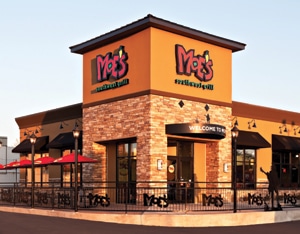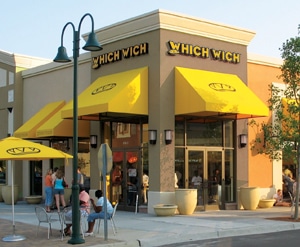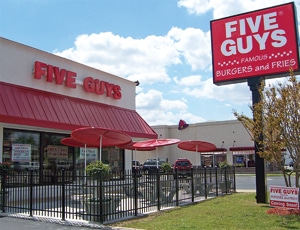Aside from all being west of the Mississippi River, Denver; Waco, Texas; and Yuma, Arizona, have seemingly little in common. One is a thriving cosmopolitan metro nestled on the rim of the Rocky Mountains; one sits in the shadow of much larger and more heralded Lone Star markets; and the other perches quietly on the nation’s southern border.
Each has its own charm and character, but all share one distinction: high potential for quick-service restaurant growth, according to QSR’s third-annual Growth 40 report.
This year’s Growth 40 comes flush with fresh insights from our new data partner, Chicago-based NPD Group, one of the world’s leading foodservice market research firms. The NPD-led Growth 40 uses historical information from the agency’s CREST reports, which track consumer usage at foodservice outlets, as well as a population forecast from California-based Applied Geographic Solutions (AGS) to produce the QSR Traffic Growth Forecast statistic.
“Population or demographic changes alone are not enough to know where restaurants are headed,” says Greg Starzynski, director of product management for NPD Group. “There’s going to be a high correlation between population increases and people going out to restaurants, but what we’re looking to forecast is the likelihood people will visit restaurants more frequently.”
While NPD Group forecasts just a 3 percent rise in the number of people visiting quick serves in the U.S. between 2011 and 2016, traffic projections for all members of the Growth 40 list—segmented as 15 large markets (more than 2.5 million residents), 15 medium (1–2.5 million), and 10 small (fewer than 1 million)—surpass that mark. The Denver, Waco, and Yuma designated market areas (DMA) stand to have the highest rise among large, medium, and small markets, respectively.
Markets in the South and West dominate the Growth 40, largely a result of the nation’s population shift. In fact, only two Northeast markets made this year’s Growth 40: Rochester and Buffalo, New York, the latter of which topped the 2011 report but only squeaked into this year’s top medium-sized markets using NPD’s data.
Large Markets
Buoyed by a projected 11 percent growth in quick-service traffic and a 6 percent jump in population, the Denver DMA climbed to the top of the Growth 40’s large-market rankings.
“When you combine Denver’s historical performance with its population growth, that’s where you see the favorable forecast for quick-service growth,” Starzynski says.
Though the Mile High City’s quick-service density (118 units per 100,000 residents) is higher than any other Growth 40 member, concepts across the quick-service arena continue expanding in the area. These include Pizza Ranch, CiCi’s Pizza, frozen-yogurt chain Menchie’s, snack retailer Doc Popcorn, Asian-inspired fast casual Mama Fu’s, and Dunkin’ Donuts, which has more than 30 units planned for the Denver area.
Several quick-service and fast-casual chains are headquartered in Denver, including Chipotle, Qdoba, and Boston Market. Smashburger is also based in Denver; it operates 12 restaurants in and around the city, and looks to open an additional 20 units there in the coming years.
Smashburger CEO Dave Prokupek values the restaurant-industry talent in Denver, its diverse populace, and the local bias toward innovation and collaboration.
“Denver is not only a melting pot of ideas, but concepts in the market also benefit from diverse demographics and varied consumer tastes, which represent a good cross section of consumers nationally,” Prokupek says.
Another Denver-area corporate resident, TCBY, places a high priority on growing in its new home market (it moved from Salt Lake City in 2012). Building off its 11 existing locations, TCBY will add several local units in 2013, including a store at TCBY corporate headquarters that will serve as the company’s new franchisee training location.
Like Prokupek, TCBY CEO Tim Casey celebrates the area’s talent base and business environment, which he calls rich in franchising, brand development, and support infrastructure.
“Many [fast-casual and quick-service] franchise companies were launched from and are based in the [Denver] area, making it an ideal environment for idea sharing,” Casey says.
After Denver, the South exerts its dominance on the Growth 40, as Washington, D.C.; Charlotte, North Carolina; Houston; and Orlando, Florida—the No. 1 market in last year’s Growth 40—round out the top five large markets.
NPD Group forecasts an 11 percent traffic increase for the District of Columbia, an area benefiting from an anticipated 8 percent jump in population and quick-serve density that is less than the national average of 101.1 units per 100,000 people.
Such positive attributes are precisely what attracted YO! Sushi to launch its first U.S. outlet in D.C. earlier this year. The London-based concept hopes to open an additional 10 units in the mid-Atlantic corridor in the coming years.
YO! Sushi business development director Alison Vickers calls D.C. “a great place to test a restaurant,” given its abundance of dual-income households, “first jobbers,” and 25–40-year-olds, which is the concept’s target demographic.
Darren Wightman, managing partner for YO! Sushi in Washington, D.C., adds that the nation’s capital is “a vibrantly youthful city that loves to eat away from home.”
Moe’s Southwest Grill, meanwhile, has 14 units in the D.C. area and recently signed a deal with three of its existing franchise partners to bring an additional 25 restaurants into the DMA. Moe’s senior director of real estate Phil Russo says the D.C. area boasts strong daytime and residential populations, as well as successful track records with other national quick-service brands.
“This market also has high disposable incomes, a stable population and employment base, as well as multiple colleges, universities, hospitals, and office complexes,” Russo says.
No. 3 Charlotte, the Tar Heel State’s largest DMA, is in the crosshairs of concepts like TCBY, Smoothie King, and upstart fast casual Burger 21.
Charlotte-based Salsarita’s Fresh Cantina has 16 restaurants in its hometown, including nontraditional locations on college campuses and in corporate parks, and one inside the Charlotte Douglas International Airport. Salsarita’s president and COO Larry Reinstein says the brand is eagerly pursuing development opportunities in the Charlotte region, which he calls a “great incubator for a growing brand.”
“The prosperity and growth that Charlotte has seen over the past decade have provided great population growth, new real estate opportunities, and a vibrant community,” Reinstein says.
Starzynski says both D.C. and Charlotte have a 50-and-up population growing faster than the national average, an age group he says historically favors quick-service traffic.
[pagebreak]
Medium Markets
While eight Texas DMAs inhabit the Growth 40 list, the Waco/Temple/Bryan DMA is the Lone Star State’s only chart-topper. Located between Dallas and Austin, the Waco DMA leads the crop of 15 medium-sized markets—and, in fact, the entire 2013 Growth 40—with a projected 21 percent growth in quick-service traffic between 2011 and 2016.
Over the last decade, the Waco DMA’s population has surged above 1 million. AGS forecasts a 13 percent population jump between 2011 and 2016; only fellow Texas DMAs Austin, Harlingen/Weslaco/Brownsville/McAllen, and Laredo match that rate among Growth 40 markets.
The growing presence of white-collar business communities—many pushing north from Austin—have complemented Waco’s entrenched institutions, such as Baylor University and Texas A&M University, as well as Fort Hood, one of the world’s largest and most active military bases, to stimulate the area’s quick-service potential.
Dunkin’ Brands vice president of development Grant Benson says the Waco DMA has long been underserved, often playing little brother to the likes of Austin, Houston, and Dallas. That, he says, will change as Dunkin’ looks to open five Waco-area units by 2017. Dallas-based sandwich concept Which Wich has three locations in the Waco area, including a shop inside Baylor’s student union. Kevin Warden, Which Wich’s area director for Texas, calls expansion in the Waco area “a natural fit” because the concept thrives in family-friendly college towns.
“[The Waco/Temple/Bryan areas] are untapped markets for our brand and part of our overall growth strategy,” Warden says.
With a projected 18 percent jump in quick-service traffic, Las Vegas comes in at No. 2 among medium-sized markets. While the recession slowed Sin City’s explosive population growth, and area unemployment remains well above the national average, people continue venturing to Las Vegas to live and play. The 2011–2016 population outlook projects a 12 percent jump, while upward of 40 million visitors travel to Vegas each year—numbers that are convincing concepts like Wingstop and Togo’s to move to town.
 Though Juice It Up! closed its two Las Vegas–area stores during the recession, senior director of business development Carol Skinner says the time is right to return to the market. The Irvine, California–based juice-bar concept looks to capitalize on real estate availability in high-traffic shopping centers, as well as on sharp declines in rental rates, to add two to three area stores within the next five years.
Though Juice It Up! closed its two Las Vegas–area stores during the recession, senior director of business development Carol Skinner says the time is right to return to the market. The Irvine, California–based juice-bar concept looks to capitalize on real estate availability in high-traffic shopping centers, as well as on sharp declines in rental rates, to add two to three area stores within the next five years.
“It’s a whole new ballgame [in Las Vegas], and we plan on finding the right partners and the right locations to grow the Juice It Up! brand,” Skinner says.
Small Markets
Sometimes the biggest opportunities come in small packages.
That’s the argument for growth in the Yuma, Arizona/El Centro, California, DMA. Among this year’s Growth 40 markets, none claim a lower quick-service density than the area tucked near the Arizona-California-Mexico border.
Kneaders Bakery & Café has a pair of units in Yuma and has considered adding a third.
Kneaders managing director James Worthington says the bakery concept benefits from local customers and a small-town feel that breeds a personal connection with customers. Worthington also touts the area’s high “snowbird” population, or people who move to town for the winter.
“These wonderful people love to eat out and we love having them,” he says.
Worthington adds that Kneaders’ bakery model is a perfect fit for smaller markets, since each store is self-sufficient and doesn’t require a large number of stores or a commissary.
“We can enter into areas where other larger brands may not,” Worthington says in a nod to the area’s competitive opportunity.
Prospects in small-market runner-up Midland/Odessa, Texas, are fueled by oil, which has driven workers into the area and local unemployment below 4 percent. Located in the less dense area of west Texas, the Midland/Odessa DMA is also the regional shopping center for residents in nearby counties.
 “When you get into west Texas, there’s a lot of miles in between places, which makes spots like Midland and Odessa frequent destinations,” says Texas Restaurant Association CEO Richie Jackson.
“When you get into west Texas, there’s a lot of miles in between places, which makes spots like Midland and Odessa frequent destinations,” says Texas Restaurant Association CEO Richie Jackson.
Like the other Texas markets on the Growth 40, Midland/Odessa benefits from the state’s hard-charging economy, business-friendly legislative environment, and a surging 25–64-year-old demographic, elements that favor quick-service spending.
“There are economies of scale restaurants pick up by coming into Texas … and an economic engine that’s running well throughout the state,” Jackson says.
A hidden gem in the eyes of many, Fargo, North Dakota, comes in at No. 3 among small markets. Fargo resident and North Dakota Hospitality Association executive director Rudie Martinson says there’s been quick-service growth in the Fargo area from both regional and national players, including Five Guys, Jimmy John’s, Pita Pit, and Erbert & Gerbert’s. He says the area’s strong economy and low unemployment continue to pull in quick serves.
“This leaves room in people’s budgets to do things like eat out more often,” Martinson says. He adds that Fargo also hosts two universities, a four-year college, and numerous technical and two-year schools, all positives for quick serves in terms of the labor pool and customer base.
Moreover, Fargo’s national profile continues to rise. In recent years, Fargo has been named one of the nation’s “top places to retire” by Forbes, and one of the best places to live by both Men’s Journal and Money Magazine.
“That kind of reputation attracts the attention of both potential franchisees and franchisors,” Martinson says.
About The NPD Group Foodservice Division
 The NPD Group is the foodservice industry’s leading source for trends and performance indicators such as traffic, consumer spending, same-store sales, check size, and consumer demographics. NPD’s rigorous foodservice market research includes CREST®, which continually tracks more than 400,000 consumer visits at commercial and non-commercial foodservice establishments a year; SalesTrack® Weekly, which monitors the same-store sales of 100,000 leading restaurants; SalesTrack® Market, which, like SalesTrack® Weekly, monitors same-store sales but on a market basis; QSR Market Monitor, a syndicated awareness, trial, and usage tracker; and CREST® Local Market, which tracks consumers’ local preferences, demographics, and restaurant visits across the country’s top media markets. For more information, visit restaurantindustrytrends.com.
The NPD Group is the foodservice industry’s leading source for trends and performance indicators such as traffic, consumer spending, same-store sales, check size, and consumer demographics. NPD’s rigorous foodservice market research includes CREST®, which continually tracks more than 400,000 consumer visits at commercial and non-commercial foodservice establishments a year; SalesTrack® Weekly, which monitors the same-store sales of 100,000 leading restaurants; SalesTrack® Market, which, like SalesTrack® Weekly, monitors same-store sales but on a market basis; QSR Market Monitor, a syndicated awareness, trial, and usage tracker; and CREST® Local Market, which tracks consumers’ local preferences, demographics, and restaurant visits across the country’s top media markets. For more information, visit restaurantindustrytrends.com.








